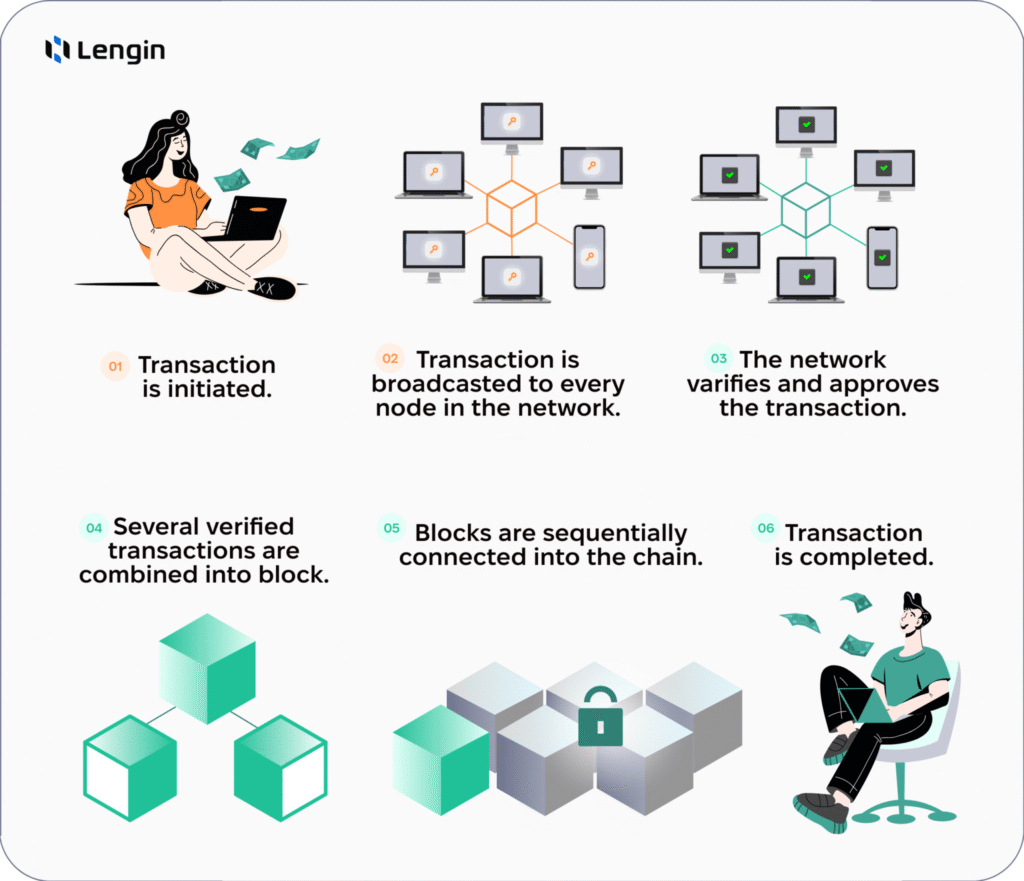JavaScript for Blockchain Development in FinTech Applications
JavaScript for Blockchain Development in FinTech Applications
The Federal Trade Commission reports that over 5.7 million people faced data breaches and identity thefts in 2022. It is, on average, 15,600 people every day.
Developing more robust security measures can’t keep up with the resourcefulness of fraudsters. In contrast, blockchain technology offers a secure and tamper-proof solution for. It eliminates the need for centralized authorities by ensuring that all transactions are recorded on a public ledger that is accessible to all participants.
The union of FinTech and blockchain has the potential to revolutionize the financial industry.
What is Blockchain and How Does It Work?
Blockchain is a distributed immutable digital ledger, which is considered the most secure approach to storing data. It is the most widely known for cryptocurrency trading, but it can be used in Fintech app to track transactions and enhance security.

The transaction goes through the blockchain in 6 steps.
- Translation: user initiates a transaction of digital assets with another user
- Verification: every initiated transaction goes through verification by nodes using a consensus algorithm. The most common example is named “proof of work,” which implies solving a cryptographic puzzle.
- Block: a bunch of verified transactions are combined into blocks. Each block contains a unique block identifier (hash), timestamp, list of transactions, and the hash from the previous block.
- Chain: blocks are connected into the chain by hash and ordered according to the timestamp.
- Ledger: the network of nodes creates the distributed ledger, where each node has a copy of the blockchain. Since the ledger is append-only, all the data can’t be removed or edited, which provides a precise list of transactions and absolute transparency.
- Smart contracts: that is the type of self-executed contacts. The terms of contracts are written directly into the code so the agreement is executed without involving third-party authorities. Also, smart contracts are either executed entirely, or all the operations are reversed due to the error. There is no partial execution which makes them the most secure contracts among existing ones.
Components of Blockchain:
- Consensus mechanism. It is an algorithm that is used for the verification of the transaction. There are many types of consensus mechanisms, like “proof of work,” “proof of stake,” “proof of authority,” and many others.
- Network protocol. The network protocol ensures that all nodes in the network possess a copy of the same ledger and receive updates on new transactions. This is usually achieved via a peer-to-peer network, where nodes can connect and exchange information.
- Node software. Each node in the blockchain system has its version of the node software to maintain the ledger.
- Smart contracts. Use Truffle for creating and integrating smart contracts into using JavaScript.
- Cryptography. It is used to protect blockchain data via the hash of each block and private and public keys for transactions.
Implementing Blockchain technologies in Fintech app brings many benefits.
Key Benefits of Blockchain Integration in Fintech App

Enhanced Security
The decentralized nature of blockchain technology ensures that no single entity has complete control over the financial system. There is a 51 percent rule, which means that hackers must control over half of the system to attempt to steal data or mislead transactions. This is literally impossible due to the broad decentralized node network.
For example, when hackers alter data on their nodes, they will have to convince millions of other nodes that their copy of the blockchain is valid. This decentralization reduces the risk of fraud and manipulation, making the financial system more trustworthy and resilient.
Also, the automatic execution of smart contracts without partial execution eliminates the possibility of manipulation by putting the error into the code. For example, if an error occurs or a condition cannot be done, smart contracts return all actions to the start canceling all previously executed actions.
The nature of blocks and chains enhances security too. Each block contains the hash of the previous one, which allows connecting them into the chain in the order of their timestamps. If any data inside the block is attempted to be changed, the hash is changing too. The previous blocks will not recognize the hash and break the chain. In most cases, the system refuses any altercations, so it is impossible to falsify data.
Improved Transparency
The blockchain network is open to anyone, so all participants can access the same information and see all transactions in real-time. Also, all blockchain transactions are traceable so that you can see the entire history and lineage of any piece of data or asset on the blockchain. They are published but encrypted, so only the data owner can reveal their identity. This way, blockchain provides transparency but, at the same time, anonymity for its users.
Greater Efficiency and Accuracy
The whole system is automatic; the only human action is initializing the transaction. Smart contracts are self-executed, so there is no need for human interference even for checking the execution of terms. Also, there is no need for centralized authority to control the data. Such automation eliminates even the tiniest possibility of human error. Also, blockchain makes all the transactions transparent and traceable, maximizing the report’s accuracy.
DeFi: Fintech App with Blockchain Technologies
JavaScript is widely used for creating blockchain-based smart contracts and DApps. DApps stands for decentralized applications. They are popular in many spheres, but the most in FinTech, so a new type of application emerged – DeFi. Decentralized Finances refers to financial products and services that run on blockchains.
The most substantial advantage of DeFi is that transactions happen peer-to-peer without banks, exchanges, and more. Everything is automatic and transparent. DeFi aims to disintermediate the traditional financial system by offering financial products and services openly and transparently, without centralized intermediaries like banks and brokerages.
DeFi systems run autonomously using smart contracts, giving users more control and accessibility. Some examples of DeFi applications include decentralized exchanges, lending and borrowing platforms, stablecoins, derivatives, insurance products, and lending robots.
Benefits of Using JavaScript for Blockchain Development

JavaScript is used for blockchain development because of its compatibility with various blockchain platforms. Many blockchain platforms, such as Ethereum, support the execution of smart contracts written in JavaScript through their respective virtual machines. This compatibility allows developers to leverage existing JavaScript libraries and frameworks to build blockchain applications more efficiently.
There is a new trend nowadays – integrating blockchain technology with other emerging technologies, such as artificial intelligence (AI) and the Internet of Things (IoT). JavaScript, with its versatility and compatibility with web standards, can play a crucial role in building seamless and interconnected systems that leverage the power of blockchain and AI/IoT.
An extended JavaScript ecosystem of libraries, frameworks, and various tools is convenient for the development of the front and back end of the application as well as for integrating fully-fetched blockchain solutions into other systems.
Popular FinTech Apps Built with JavaScript and Blockchain
Digital wallets and portfolio management applications are the most common examples of DeFi. You have already heard about them but didn’t know about the combination of JavaScript and Blockchain behind the curtains.
Brave Browser
Several popular FinTech applications have been built using JavaScript and blockchain technology. One notable example is Brave Browser, a privacy-focused web browser that integrates blockchain-based advertising and rewards. Brave Browser uses JavaScript to power its user interface and interacts with the Ethereum blockchain to reward users for their attention while browsing.
ChainLink
Another example is Chainlink, a decentralized oracle network that connects smart contracts with real-world data and external APIs. Chainlink’s infrastructure is built using JavaScript, allowing developers to create smart contracts that securely access off-chain data. This integration of JavaScript and blockchain enables the creation of smart contracts that can interact with real-world events, enabling a wide range of decentralized applications.
Blue Wallet
Blue Wallet is a free and open-source wallet app for managing Bitcoin and Bitcoin Cash, available for both iOS and Android. This mobile application was developed with React Native, part of the JavaScript ecosystem. Due to this tech stack, Blee Wallet has a simple and intuitive user interface designed to be easy to use for beginners. Also, blockchain was integrated with JavaScript only and supports all necessary financial operations.
Zerion
Zerion is a portfolio management app for decentralized finance. Built with JavaScript, it provides a unified interface for users to track their holdings and activities across multiple DeFi protocols like Compound, Aave, Yearn, and others.
When users connect their crypto wallets to Zerion, it aggregates their DeFi-related data from various sources and displays it all in one place. This includes loan positions, yield farmings, tokens staked, and more. Zerion also shows metrics like total value locked, interest earned, and performance charts over time.
Zerion also allows users to perform actions within its interface, like depositing funds into lending protocols, claiming rewards from yield farms, and rebalancing positions. All its features are made possible through Zerion utilizing APIs and JavaScript SDKs from different DeFi platforms.
JavaScript Technologies for Blockchain Development
The JavaScript ecosystem contains various libraries for building robust security and maintaining high bandwidth in FinTech app with blockchain.
Web3.js
It’s is a collection of libraries that allow you to interact with a decentralized blockchain network like Ethereum from JavaScript. Web3.js provides a JavaScript API for full engagement with the Ethereum blockchain network and will enable you to integrate Ethereum functionality into your JavaScript applications, DApps, and websites.
Provided functionality includes:
- Interaction with smart contracts.
- Managing cryptography as it includes libraries to generate and manage keys for signing transactions and encrypting data.
- Work with Ethereum wallets.
- Query the Ethereum blockchain for information like contract balances, transaction details, block details, and more.
Ethers.js
Ethers.js is a JavaScript library that helps you interact with Ethereum from JavaScript. It’s considered a newer alternative to older and more popular Web3.js. Ethers.js provides the same functionality as Web3.js but some additional features.
- Web3.js is designed to work in browsers, as it works with a Web3 provider. Ethers.js works in browsers, Node.js, and anywhere JavaScript runs.
- Ethers.js handles transactions, wallet management, and contract interactions more concisely.
- Ethers.js exposes more lower-level operations, giving you more flexibility and control.
Crypto.js
Crypto.js is a comprehensive cryptography library written in JavaScript. It provides a convenient and standard way to do cryptography in JavaScript. You can quickly hash, encrypt, decrypt, sign and verify data in your web apps. The API is also easy to use, with a clean, intuitive syntax. In addition, Crypto.js aims to be a cross-browser and lightweight solution.
There are some of the most popular cases of usage of Crypto.js:
- Storing hashed passwords instead of plain-text passwords.
- Encrypting sensitive data before storing it.
- Signing data to verify authenticity and integrity.
- Generating keys for encryption and many more.
Truffle
It’s is a development environment, testing framework, and asset pipeline for Ethereum that allows using JavaScript for all its functionality. Truffle is designed to deal mainly with smart contracts rather than the whole blockchain.
Truffle provides a set of usable tools:
- Compilation and testing tools.
- Tools to deploy to any Ethereum network.
- Tools to interact with contracts from web apps.
- Migrations to manage contract updates.
- An asset pipeline to manage frontend assets
Also, Truffle Teams is a dev environment built on Truffle that allows you to develop Dapps in JavaScript using React, Vue, and plain JavaScript. Truffle Contract library, written in JavaScript, facilitates the development and integrations even more.
Lisk
It’s is an open-source blockchain platform that allows developers to quickly build and deploy decentralized applications using JavaScript and the Lisk SDK. Lisk enables JavaScript developers to build swiftly innovative fintech DApps like decentralized exchanges, lending platforms, stablecoins, and more.
Lisk uses a sidechain architecture where each DApp runs on its own sidechain while being secured by the main Lisk blockchain. According to the requirements, sidechains can be merged or added, which provides flexibility and scalability for FinTech app.
The Lisk SDK is a development kit for writing DApp code in JavaScript and TypeScript. The SDK provides tools and libraries that simplify the development process by abstracting away many of the complexities of the blockchain, streamlining the time to market, and enabling focusing on the business logic instead of solely development.
Conclusion
Blockchain is the most secure way of storing and manipulating data nowadays. This is about more than just cryptocurrency because this approach applies to any application that includes transactions. That’s why blockchain has become a popular solution for developing DeFi – decentralized financial applications.
The increased focus on privacy and data protection is likely to drive the development of privacy-centric blockchain solutions. JavaScript is the most popular programming language, which can contribute to developing privacy-focused blockchain platforms and applications that provide users with complete control over their data and transactions.



